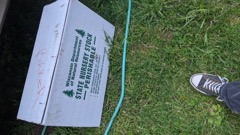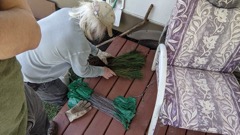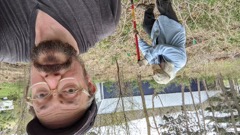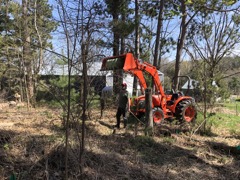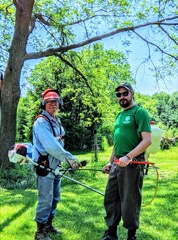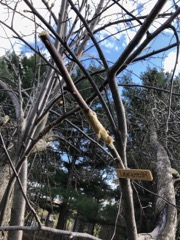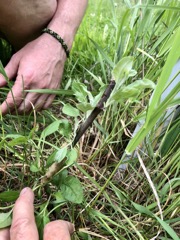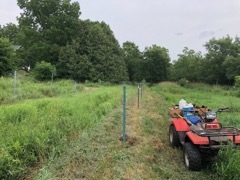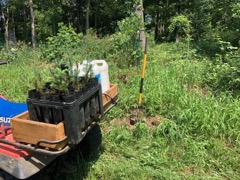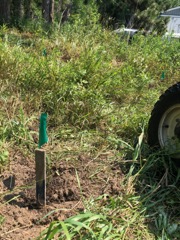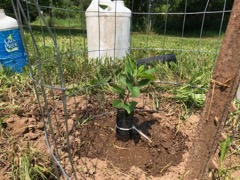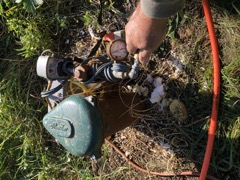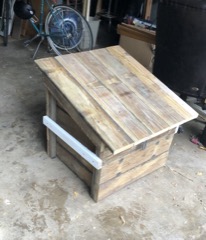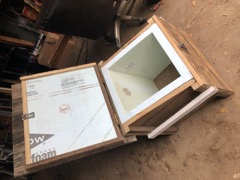Treenut's Forest Notes for 2021
Back in the woods
2021 Farm Notes:
- Set out 300 transplants from DNR (200 white spruce and 100 red pine).
- Clear brush in 'windbreak' N. of homestead. in prep for transplants.
- First attempt at grafting apple trees.
- Transplant new apple seedlings and Oak seedlings from my nursury.(in cages)
- Clear brush over and around new plantings (release) in windbreak.
- Plant Oak, Apple, and Spruce from personal nursery to fill gaps in bottom, orchard, and windbreak.
- Build new 'Well house' to cover well head and replace trash can cover.
April 31, 2021: Trees arrive at County Center.
I originally orderred these trees for 2020 but due to the pandemic, I cancelled the order. The DNR asked if I wanted to them to send it out this year instead. So I now have 3-year trees instead of 2-year. This may be good because they will have to grow fast to compete with the brush where I'm putting them.
We placed one of these blue flags next to every transplant so we could find them again once the weeds and brush grew up around them -- as it did with a vengence.
May first, 2021: Quick video of Lance and I transplanting Spruce and Pine
Planting Pine/Spruce in 'Windbreak'
Lance and I planted 300 seedlings within the remains of the old windbreak along the hillside nust north of the farmstead.
Two weeks prior to this we cut down any brush that remained standing after the winter. This was mainly Elderberry and Box Elder. The snow had taken dwon the raspberry and the vines (Virginia Creeper wild cucumber and Grape). This is why the forest floor looks fairly barren -- this will change drastically in a couple weeks.
Watering in transplants
The soil was pretty wet this spring when we planted. But there was no more rain in the forecast for at least 14 days so we decided that a little water and miracle grow would give these little trees a leg up.
This high tank contraption worked well for the first day's transplants but as we worked higher on the hillside I could no longer drive up into the woods. So Lance went around with the backpack sprayer (without nozzel) and gave each tree a littl drink.
As it turned out, the rain stayed away for nearly a month so this little 'ounce of prevention' probably saved some lives (trees).
June 5, 2021: Transplant Release (more brush cutting)
One month after planting the forest floor had already changed dramatically. The brush and weeds already had a solid start and were overtopping the new trees. If we hadn't used the blue flags there was no way we would be able to find these little trees. And if you can't find the trees, you can't 'mow' around them.
Once again I cut the brush and weeds around each transplant with this Stihl FS-90 brush cutter with a 'star' brush blade. This works great on grass, weeds, brush and even small trees. Lance followed me with a sprayer and treated the stumps with a 3% mix of 'Roundup'.
Stuart and Lance clearing brush and treating stumps...
April 2021: Grafting Apple trees.
Scions from a Macintosh and Winesapp ...
I cut some twigs from a neighbor's trees, before they budded out, and kept them in a fridg until we went up north to the farm.
With instructions from my nephew John, and some grafting tools and equipment, we grafted about a dozen scions to various trees in our orchard at the farm. Many were grafted to seedlings which were planted in 2018 and had survived deer brows and grass competition. A handfull were grafted onto twigs on mature trees.
the cutting tool made quick and accurate 'V' shaped cuts in both halves of the graft. We joined the pieces together and wrapped with surgical tape. Then we coated the joint completely with melted grafting wax from a pan we had heating on a hotplate powered by an inverter that we carried on the brush hog behind the tractor.
Click on image to enlarge
May 2021: Apple Graft Success.
Unbelievable
About two weeks later, Lance and I went back to the farm and found that many of the grafts had taken (succeeded).
I believe we had about a 70-80% success rate on these grafts. I think that is what is called 'beginner's luck'.
I have now checked these grafts again -- in the middle of June -- and they are all doing nicely. They are growing leaves and even some new stems.
I have carefully replaced all the cages (for the deer) and made sure the base of the trunk is wrapped with screen to keep the mice away. I have also sprayed deer repelant on the seedling grafts as an extra measure
Click on image to enlarge
June 2021: Fill planting Oak, Apple, Spruce:
Left: Filling in some gaps in lower field area below old barnyard.
Oak seedlings (3-year) from D40 pots. The ground is pretty dry so I soaked these well after planting. Eack is marked with wooden stake and caged.
Below: Replacing failed spruce transplants in windbreak area.
A few of the Spruce seedlings from the DNR were too small to plant so I potted them and pampered them for two months -- mainly to see if they would make it -- and now I am replacing some of the failed transplants with these rescues.
The ground is much drier now and I am careful to keep as much of the potting mix on the roots as I move them into the ground. I then soak the soil well with a Mirracle Grow sollution.
[Click on pictures to enlarge]
More Apple seedlings adding root stock to orchard.
I started a few dozen apple seedlings this spring and I brought a couple of these up to the orchard to fill in where previous transplants have failed.
This is late for trying to transplant but since these are in pots and not bare-root, I thought it worth a trY.
The soil is dry so I give each one a good drink, wrap the base with screen(for mice) and put cage around the whole thing (for deer).
[Click on pictures to enlarge]
October 2021: Build Shelter for Well Head.
Well head.
The water well is configured such that the pressure tank is located underground and right next to the well. (This is because this well fed both the barn and the house.) This means the pressure switch is located on the well head and is above ground and exposed to freezint temperatures in the winter.
For years, I have just used foam "rose cone" inside a overturned garbage can to cover this well. I have a light bulb located inside along with some heat tape, controlled by a thermostat.
Below Left: Outide view of shelter.
I've built an insulated shelter out of recycled deck wood and salvaged foam insulation pieces.
Below Right: Inside view of shelter.
I added a hinged roof to ease access for the annual re-charge of air in the pressure tank.
[Click on pictures to enlarge]
